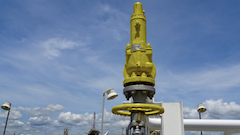Green Rot is a form of internal oxidation of chrome-nickel-iron alloys that causes embrittlement is certain process equipment. It occurs in circumstances where there exists a simultaneous carburizing and oxidizing of a material and tends to be more common in alloys that contain 65% or more nickel. This damage mechanism causes the alloy ingredients that were originally intended to produce a protective external oxide scale, to instead produce a deleterious internal oxide precipitate, which gives rise to brittle fracture. When the component fails due to "green rot", the fresh fracture surface exhibits a greenish tint, not unlike that of rotten wood, caused by the internal oxide precipitates (usually chromium oxide (Cr2O3)) that caused the embrittlement. Hense the name.
Green rot is incredibly insidious because it can happen very rapidly and cause dangerous failures. It tends to occur most often in areas such as heat-treating furnaces that are kept heated at temperatures of 1500 to 1800°F (815 - 980°C) for long periods of time. Of course, it can also become a problem in any other areas where simultaneous carburizing and oxidizing of the material can occur such as blocked cooling jets or bright annealing furnaces. The good news is that, as far as damage mechanisms go, green rot is incredibly rare. It only occurs in very specific circumstances and thus isn’t likely to affect a facility that is prepared for it.
In order to prevent green rot, it is important to make sure the materials selected for the environment are not susceptible to internal oxidation. Thus, material selection is very important when working in environments where green rot is possible.
Related Topics
- Brittle Fracture
- Carburization
- Cavitation
- CO2 Corrosion
- Cooling Water Corrosion
- Corrosion Fatigue
- Corrosion Under Insulation (CUI)
- Cracking
- Decarburization
- Embrittlement
- Erosion Corrosion
- Fatigue (Material)
- Flue Gas Dew Point Corrosion
- Graphitization
- High Temperature Hydrogen Attack (HTHA)
- High-Temperature Creep
- Hydrochloric (HCl) Acid Corrosion
- Hydrofluoric (HF) Acid Corrosion
- Hydrogen Embrittlement
- Hydrogen Stress Cracking
- Liquid Metal Embrittlement (LME)
- Metal Dusting
- Microbiologically Influenced Corrosion (MIC)
- Naphthenic Acid Corrosion (NAC)
- Phosphoric Acid Corrosion
- Pitting Corrosion
- Spheroidization (Softening)
- Stress Assisted Corrosion
- Sulfidation Corrosion
- Sulfuric Acid Corrosion
- Thermal Fatigue
- Vibration-Induced Fatigue
- Wet H2S Damage
Relevant Links
Topic Tools
Share this Topic
Contribute to Definition
We welcome updates to this Integripedia definition from the Inspectioneering community. Click the link below to submit any recommended changes for Inspectioneering's team of editors to review.
Contribute to Definition


















